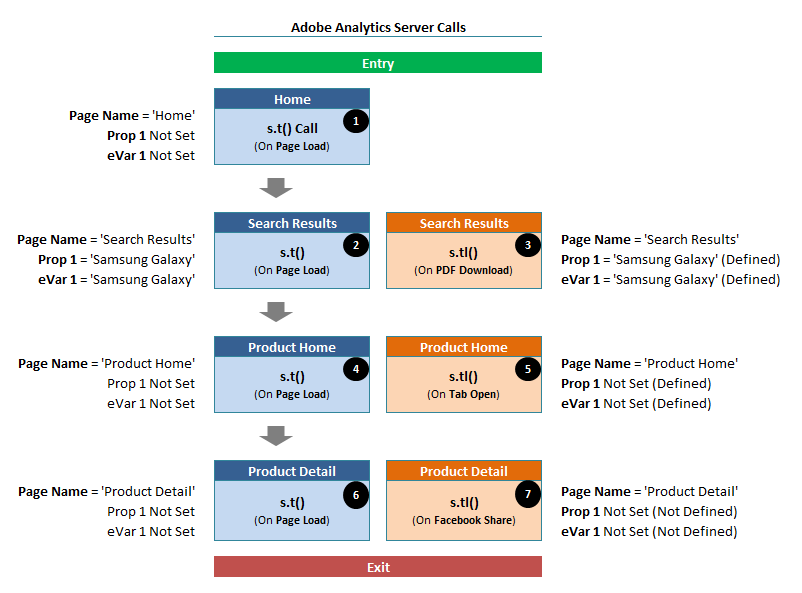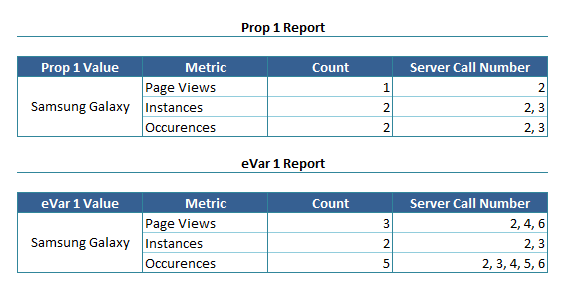My team recently asked me about the exact difference between the metrics Page Views, Instances and Occurrences after reading the article ‘Compare Page Views, Instances and Occurrences‘ from Adobe. I was wondering, didn’t the article provide the difference? It is perfect for me. The next day, as I began my class, the same question emerged. I have shared the link to them, but the question remained the same. Ho no!
Often you were challenged by someone to clarify the difference or you were seeking clarification from someone, didn’t you? I was seeking the clarification to myself and thus want to compose this post even though it is too basic.
Adobe Analytics data collection is based on the Server Requests i.e. Server Calls. It will either be a PageView Server Call (s.t()) or a Non-PageView Server Call (s.tl()). Assuming that we know these topics, let’s see the below visitor journey and visit actions. Consider, eVar1 expiration is set to visit.
Shorting the visiting journey and actions with words again: Visitor entered ‘Home’ page, searched for ‘Samsung Galaxy’ in ‘Home’ page Search Bar and landed ‘Search Results’ page, clicked on TnC to download the same before navigating to ‘Product Home’ page. Reached ‘Product Home’ page, clicked on the recommendations tab to see the product recommendations, navigated to ‘Product Detail’ page and shared the page using ‘Facebook’ share. So, there are combinations of PageView and Non-PageView Server Calls during the visitor journey. For our reference and use, I have provided number for the Server Calls (Black circle).
Prop 1 and eVar 1 report for ‘Samsung Galaxy’ line item will look like below.
Now, let us apply Adobe’s definitions on our visitor journey together for Prop 1 and eVar 1.
Page Views (Definition): Displays the number of times a variable was defined or persisted across all PageView Server Calls within the given date range. Does not include Non-PageView Server Calls.
Thus, only PageView Server Calls should be accounted.
Prop 1 is set in the PageView Server Call 2, since it won’t persist, the Page Views for ‘Samsung Galaxy’ is only 1.
eVar 1 is set in the PageView Server Call 2, since because it persist till the end of the visit, the Page Views for ‘Samsung Galaxy’ is 3. Have included PageView Server calls 4 and 6 only.
Instances (Definition): Shows the number of times a given variable was defined in any image request, including PageView and Non-PageView Server Calls. Does not include persisted values.
Thus, we can account both PageView & Non-PageView Server Calls ignoring persistence.
Prop 1 is set in the Page View Server Call 2 and Non-Page View Server Call 3, since it won’t persist, the instances for ‘Samsung Galaxy’ is 2.
eVar 1 is also set in the Page View Server Call 2 and Non-Page View Server Call 3, since it does not include persisted values, instances for ‘Samsung Galaxy’ is also 2.
Occurrences (Definition): Counts the number times a variable was defined or persisted across both PageView and Non-PageView Server Calls.
Thus, we can account both PageView & Non-PageView Server Calls including persistence.
Prop 1 is set in the Page View Server Call 2 and Non-Page View Server Call 3, since it won’t persist, the occurrences for ‘Samsung Galaxy’ is only 2.
eVar 1 is set in the Page View Server Call 2 and Non-Page View Server Call 3, since we need to include the persistence that include both PageView Server Call and Non-PageView Server Call, we need to include PageView Server Calls 4 and 6 as well as Non-PageView Server Call 5, the occurrences for ‘Samsung Galaxy’ is 5.
I’m not going to include the Non-PageView Server Call 7 because eVar 1 is not defined for the Server Call. Note that we should manually define the variables in Non-PageView Server Call (Unlike PageView Server Call) in order to leverage the persistence: Checkout linkTrackVars for more details.
Hi 5! The difference between Page Views, Instances and Occurrences was successfully understood. Now, we can explain the topic to anyone without complications.
Bonus: Based on the example above, we can define few more things.
- For a Traffic Variable, Occurrences = Instances and Page Views <= Instances.
- For a Conversion Variable, Occurrences >= Page Views >= Instances.









Long time supporter, and thought I’d drop a comment.
Your wordpress site is very sleek – hope you don’t mind me asking what theme you’re using?
(and don’t mind if I steal it? :P)
I just launched my site –also built in wordpress like yours– but the theme slows (!) the site down quite a bit.
In case you have a minute, you can find it by searching for “royal cbd” on Google
(would appreciate any feedback) – it’s still in the works.
Keep up the good work– and hope you all take care of yourself during the coronavirus scare!
Hello Justin,
Thanks for you support and comment. I am using Twenty Seventeen Blog Theme right now. Till now i didn’t concentrate on the look and design rather only on my posts, but need to work on it in the future. I have seen your site and it looks pretty cool to me. Since mine is a blog and yours is partial eCommerce, there will be a difference. But i don’t think that is a show stopper. Hope you are also fine and away from Covid-19, great day.
Thank You,
Arun
alot of info thank u alot